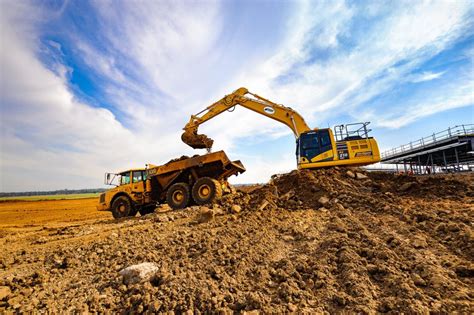excavation compaction Compaction after excavation is the process of pressing down loosened soil to . EXCAVATOR SY16C STANDARD FEATURES 18.2 hp Net Power 7’ 9” Dig Depth 4,023 lbs Operating Weight 3,732 lbf Bucket Breakout Swing boom functionality . In the interest of continual equipment development, SANY America Inc. reserves the right to change these specifications at any time without prior notification.
0 · What is Earthwork in Construction?
1 · What Are Earthworks In Construction
2 · How to Compact Soil After Excavation: Your Step
3 · Excavation and Compaction; how they A
The Komatsu PC138US-10 is a compact and versatile hydraulic excavator with a short tail swing and a powerful EU Stage IIIB engine. It offers six working modes, a wide choice of options, .Price. Hours. Hours. Horsepower. Horsepower. ROPS. High Pressure Hydraulics. Drive. . Komatsu equipment on the market includes crawler and mini excavators, wheel . and skid-steer loaders. Popular model series include Komatsu D65 crawler dozers, PC210 crawler .
Compaction after excavation is the process of pressing down loosened soil to .

Compaction must take place during a fill operation to increase the density of the soil material being placed. Another common breakdown in excavation work is bulk excavation and trench excavation. Swell and shrinkage are two important, and often misunderstood, terms. Compaction after excavation is the process of pressing down loosened soil to eliminate air pockets and increase soil density. This ensures that the ground can support structures and prevents future issues like settling, erosion, or water pooling.
Learn about soil compaction, its types, methods, and effects on soil types and construction projects. Find out how to identify and classify soil, and how to achieve optimal density and moisture content.
Learn about the earthwork operations and requirements for roadway construction projects in California. Find out how to prepare, inspect, and pay for excavation, backfill, embankment, compaction, and other earthwork activities.Learn the sequence, procedure and quality checks for excavation and backfilling of soil in construction. Find out the materials, tools, drawings and guidelines for earthwork in foundation and trench construction. In this article we’ll cover how to calculate cubic yards of excavation and backfill, soil types, excavation equipment, soil testing, compaction, swell factor, the difference between excavating and trenching, and when shoring or trench supports are required.
Learn how to choose the right compaction equipment for different soil types and job sizes. Find out how to improve safety and efficiency with remote control, low emissions and low-vibration. Soil compaction is a vital step in building construction, providing a stable foundation for structures. By following proper preparation, using appropriate compaction methods and equipment, and conducting regular monitoring .Soil compaction is an essential step for increasing soil density, eliminating air pockets and maximizing ground load-bearing capacity. The compaction process must be tailored to the particular characteristics of each soil type – such as dirt, clay, sand or gravel.
Learn how to plan, execute and control excavation work on construction projects. Find out about erosion and sedimentation control, clearing and grubbing, site and building demolition, earthwork excavation and compaction, rock excavation, water effects and more.Compaction must take place during a fill operation to increase the density of the soil material being placed. Another common breakdown in excavation work is bulk excavation and trench excavation. Swell and shrinkage are two important, and often misunderstood, terms. Compaction after excavation is the process of pressing down loosened soil to eliminate air pockets and increase soil density. This ensures that the ground can support structures and prevents future issues like settling, erosion, or water pooling.Learn about soil compaction, its types, methods, and effects on soil types and construction projects. Find out how to identify and classify soil, and how to achieve optimal density and moisture content.
Learn about the earthwork operations and requirements for roadway construction projects in California. Find out how to prepare, inspect, and pay for excavation, backfill, embankment, compaction, and other earthwork activities.Learn the sequence, procedure and quality checks for excavation and backfilling of soil in construction. Find out the materials, tools, drawings and guidelines for earthwork in foundation and trench construction.
What is Earthwork in Construction?
In this article we’ll cover how to calculate cubic yards of excavation and backfill, soil types, excavation equipment, soil testing, compaction, swell factor, the difference between excavating and trenching, and when shoring or trench supports are required. Learn how to choose the right compaction equipment for different soil types and job sizes. Find out how to improve safety and efficiency with remote control, low emissions and low-vibration. Soil compaction is a vital step in building construction, providing a stable foundation for structures. By following proper preparation, using appropriate compaction methods and equipment, and conducting regular monitoring .Soil compaction is an essential step for increasing soil density, eliminating air pockets and maximizing ground load-bearing capacity. The compaction process must be tailored to the particular characteristics of each soil type – such as dirt, clay, sand or gravel.
bobcat 863 skidsteer
326e john deere
What Are Earthworks In Construction

How to Compact Soil After Excavation: Your Step

The TB370W wheeled excavator provides owner/operators with a highly versatile option that combines powerful excavating performance with on-road capabilities, making it ideal for shorter-term, faster-paced projects.Calculating appropriate volume is critical to accuracy. In-bank soil, loose soil that has been excavated and fill soil that has been compacted, have different material densities and resulting load factors. See more
excavation compaction|Excavation and Compaction; how they A